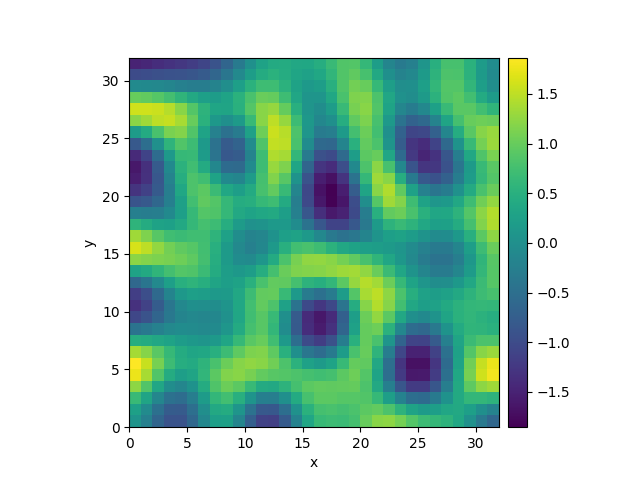Note
Go to the end to download the full example code
2.6. Kuramoto-Sivashinsky - Using PDE class
This example implements a scalar PDE using the PDE. We here
consider the Kuramoto–Sivashinsky equation, which for instance
describes the dynamics of flame fronts:
\[\partial_t u = -\frac12 |\nabla u|^2 - \nabla^2 u - \nabla^4 u\]

0%| | 0/10.0 [00:00<?, ?it/s]
Initializing: 0%| | 0/10.0 [00:00<?, ?it/s]/home/docs/checkouts/readthedocs.org/user_builds/py-pde/checkouts/0.29.0/pde/grids/boundaries/local.py:1822: NumbaDeprecationWarning: The 'nopython' keyword argument was not supplied to the 'numba.jit' decorator. The implicit default value for this argument is currently False, but it will be changed to True in Numba 0.59.0. See https://numba.readthedocs.io/en/stable/reference/deprecation.html#deprecation-of-object-mode-fall-back-behaviour-when-using-jit for details.
def virtual_point(
0%| | 0/10.0 [00:15<?, ?it/s]
0%| | 0.01/10.0 [00:27<7:39:23, 2759.15s/it]
0%| | 0.02/10.0 [00:27<3:49:28, 1379.60s/it]
1%|1 | 0.11/10.0 [00:27<41:20, 250.84s/it]
44%|####4 | 4.45/10.0 [00:27<00:34, 6.20s/it]
44%|####4 | 4.45/10.0 [00:27<00:34, 6.21s/it]
100%|##########| 10.0/10.0 [00:27<00:00, 2.76s/it]
100%|##########| 10.0/10.0 [00:27<00:00, 2.76s/it]
from pde import PDE, ScalarField, UnitGrid
grid = UnitGrid([32, 32]) # generate grid
state = ScalarField.random_uniform(grid) # generate initial condition
eq = PDE({"u": "-gradient_squared(u) / 2 - laplace(u + laplace(u))"}) # define the pde
result = eq.solve(state, t_range=10, dt=0.01)
result.plot()
Total running time of the script: ( 0 minutes 27.838 seconds)